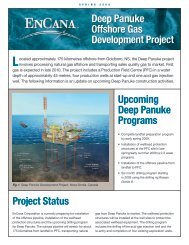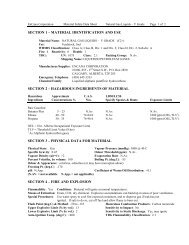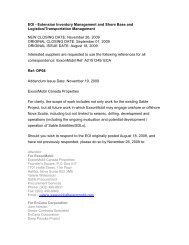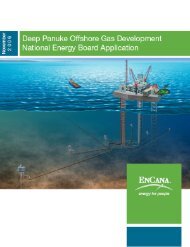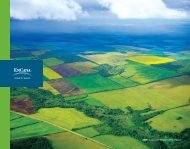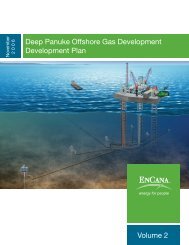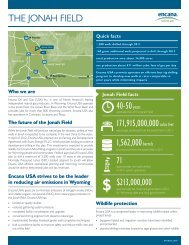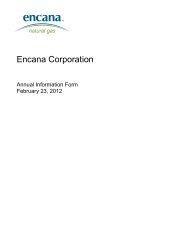Deep Panuke Project Description - Encana
Deep Panuke Project Description - Encana
Deep Panuke Project Description - Encana
You also want an ePaper? Increase the reach of your titles
YUMPU automatically turns print PDFs into web optimized ePapers that Google loves.
For the new production and injection wells drilled, the conductor pipe (first string of pipe) will be setapproximately 100 m below the seafloor. This is the same method that has been used on the existingsuspended delineation wells. This section will be drilled primarily with seawater and viscosifiers to aidin ensuring cuttings removal from the wellbore. These cuttings are deposited at the seabed and aregenerally equivalent to the volume of the hole drilled, approximately 65 m³.The conductor pipes will serve as the primary weather barrier to take environmental loading and protectthe inner strings of casing (length of pipe) while drilling the well. The conductors also take the surfaceloading implied by the other strings of casing that are returned to the mudline suspension system. Oncethe drilling has been completed, the conductors will be removed and the well will be converted to asubsea wellhead. With the production tree installed, a high pressure riser will be required to tieback tothe surface blowout preventor (BOP) stack. The high pressure riser will be designed to withstand theenvironmental loads as well as all internal design loads.All wells, including production and injection, will set the surface casing into the Wyandot member atapproximately 950 m below sea level in the general direction that the bottom of the well will be located.The BOP stack is then installed on top of the surface casing prior to drilling the intermediate holesection.For the re-entry wells, an intermediate hole section has been drilled just into the top of the limestone atapproximately 3200m true vertical depth (TVD). An intermediate casing string has been set 20 m intothe Abenaki 7/6 formation and cemented back just above any potential hydrocarbon bearing sands(~2300 m). The new production well(s) will be similarly constructed to the existing suspendeddelineation wells. Prior to drilling the reservoir section and with the well secured, the surface wellheadand conductor will be removed and the well will be converted to a subsea wellhead. The production treewill be installed with high pressure riser connected back to the surface BOP stack.A rotating BOP and an injection spool will be installed with the surface BOP stack in preparation forannular velocity control (AVC) drilling techniques and the main hole section will be drilled through theproductive interval of the carbonate reef. On the re-activation wells, the reservoir section has beendrilled to a total depth of circa 3650 m TVD which is about 150 m past the gas-water contact (GWC) at3504 m TVD. On many of the delineation wells, this GWC was not clearly evident while drilling thesection as the formation was not porous at this depth, however it was clearly identified while drilling theMarCoh D-41 well. On each of the wells to be re-used for production, a liner (string of pipe) has beeninstalled across the reservoir section and cemented back to the previous casing shoe. For the newproducing well(s), the reservoir section may be left open, with no liner in place, in order to maximize theflow potential of the well.<strong>Deep</strong> <strong>Panuke</strong> Volume 4 (Environmental Assessment Report)• November 2006 2-24





